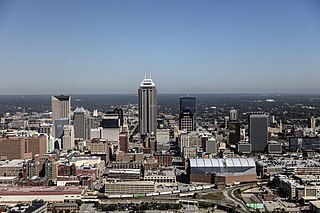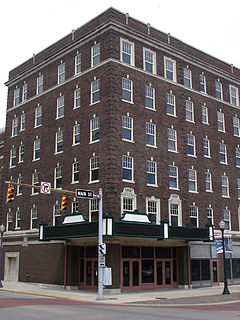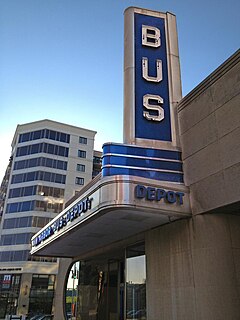
Evansville is a city in and the county seat of Vanderburgh County, Indiana, United States. The population was 117,429 at the 2010 census, making it the state's third-most populous city after Indianapolis and Fort Wayne, the largest city in Southern Indiana, and the 232nd-most populous city in the United States. It is the central city of the Evansville metropolitan area, a hub of commercial, medical, and cultural activity of southwestern Indiana and the Illinois–Indiana–Kentucky tri-state area, that is home to over 911,000 people. The 38th parallel crosses the north side of the city and is marked on Interstate 69.

Portland Union Station is a train station in Portland, Oregon, United States, situated near the western shore of the Willamette River in Old Town Chinatown. It serves as an intermediate stop for Amtrak's Cascades and Coast Starlight routes and, along with King Street Station in Seattle, is one of two western termini of the Empire Builder. The station is a major transport hub for the Portland metropolitan area with connections to MAX Light Rail, the Portland Streetcar, and local and intercity bus services. The station building contains Wilf's Restaurant & Bar on the ground level and offices on the upper floors. It also has Amtrak's first Metropolitan Lounge on the West Coast, which is reserved for first-class sleeping car and business-class passengers.

Denver Union Station is the main railway station and central transportation hub in Denver, Colorado. It is located at 17th and Wynkoop Streets in the present-day LoDo district and includes the historic station house, a modern open-air train shed, a 22-gate underground bus station, and light rail station. A station was first opened on the site on June 1, 1881, but burned down in 1894. The current structure was erected in two stages, with an enlarged central portion completed in 1914.

St. Louis Union Station is a National Historic Landmark train station in St. Louis, Missouri. At its 1894 opening, the station was the largest in the world that had tracks and passenger service areas all on one level. Traffic peaked at 100,000 people a day the 1940s. The last Amtrak passenger train left the station in 1978.

The Indianapolis Union Station is an intercity train station in the Wholesale District of Indianapolis, Indiana. The terminal is served by Amtrak's Cardinal line, passing through Indianapolis three times weekly.

Downtown Indianapolis is a neighborhood area and the central business district of Indianapolis, Indiana, United States. Downtown is bordered by Interstate 65, Interstate 70, and the White River, and is situated near the geographic center of Marion County. Downtown has grown from the original 1821 town plat—often referred to as the Mile Square—to encompass a broader geographic area of central Indianapolis, containing several smaller historic neighborhoods.

The Victory Theatre is a 1,950 seat venue in Evansville, Indiana. It is home to the Evansville Philharmonic Orchestra and also hosts local ballet and modern dance companies, theatre companies, and touring productions.

Hyatt Regency Seattle, also known as 808 Howell Street and 8th & Howell, is a high-rise hotel in the Denny Triangle neighborhood of Seattle, Washington that opened in December 2018. The 45-story hotel, operated by Hyatt, has 1,260 hotel rooms and is the largest in the city. It also has 103,000 square feet (9,600 m2) of meeting and event space, as well as two ballrooms and a lounge.
Transportation in Indianapolis consists a complex network that includes a local public bus system, several private intercity bus providers, Amtrak passenger rail service, four freight rail lines, an Interstate Highway System, two airports, a heliport, bikeshare system, 115 miles (185 km) of bike lanes, and 110 miles (177 km) of trails and greenways. The city has also become known for its prevalence of electric scooters.

Citizens National Bank, since known as the Hilliard-Lyons Building and Kunkel Square, is a building noted for its stone and terracotta facade, located at Fourth and Main Street in downtown Evansville, Indiana. The building is ten stories tall and was the region's first skyscraper. The architect was William Lee Stoddart. It officially opened on Washington's birthday in 1916. In 2011 the building was converted to 46 luxury apartments.

The Ford Center is a multi-use indoor arena in downtown Evansville, Indiana with a maximum seating capacity of 11,000. It officially opened in November 2011 and is mainly used for basketball, ice hockey, and music concerts. It is home to the Evansville Thunderbolts minor league hockey team in the Southern Professional Hockey League and the Evansville Purple Aces men's basketball team, representing the University of Evansville. The UE women's basketball team also played at Ford Center from the venue's opening, but moved its home games back to its campus starting with the 2017–18 season.

Downtown Evansville is the central business district of Evansville, Indiana. The boundaries of downtown Evansville have changed as the city has grown, but they are generally considered to be between Canal Street at the south and east, the Lloyd Expressway to the north, Pigeon Creek to the northwest, and the Ohio River to the southeast south and southwest. Downtown Evansville is entirely within Pigeon Township.

The Masonic Temple in Evansville, Indiana, USA, is a building from 1913. It was designed by the local architects Shopbell & Company in Classical Revival style. The lodge building once hosted three separately chartered Masonic lodges: Evansville Lodge, Reed Lodge and Lessing Lodge. The building measures 72 x 104 feet, with four stories above ground and a basement. The exterior walls of the first two floors are faced with stone and the stories above are trimmed with both stone and terracotta. The interior floors and partitions are supported by steel columns and girders, also following the Roman classic order.

The Eagles Home is a historic building located in Evansville, Indiana. It was designed by Evansville architect Harry Boyle and was built in 1912. It has served as a clubhouse, college, and law firm. The building was added to the National Register of Historic Places in 1982. It currently serves as the Evansville office of the Jackson Kelly law firm.

The McCurdy Hotel is a historic building in the Riverfront District of Evansville, Indiana. It was designed by architect Henry Ziegler Dietz and built in 1916–1917 in the Colonial Revival style. The McCurdy was constructed on the former site of the St. George Hotel, which was razed in 1915. It opened for business on June 17, 1917, and closed on March 16, 1969, due to bankruptcy. In Spring 2017, the McCurdy Hotel building was reopened as redeveloped apartments.

The Old Greyhound Terminal was a bus terminal serving Greyhound Lines located at 1100 New York Avenue NW in Northwest, Washington, D.C. in the United States operating from 1940 to the 1980s. It was used extensively during World War II to transport servicemen, and played a minor role in the Civil Rights Movement. It was saved through the intervention of preservationists. Most of the building was incorporated in the new 1100 New York Avenue high-rise office building when it was built in 1991.

The Ann Arbor Bus Depot was an intercity bus station located at 116 W. Huron in Ann Arbor, Michigan. It was built in 1940 as the Eastern Michigan Motorbus Terminal, and operated as a bus station until its demolition in 2014. It was designed by the Cleveland-based architects Banfield and Cumming, in partnership with Ann Arbor architect Douglas Loree, in an Art Deco style. Between 1988 and 2001, it was listed as an Individual Historic Property on the Ann Arbor Register of Historic Places. The Bus Depot was demolished in 2014 to make way for a six-story, 110-room hotel on the property, although its facade and marquee are being preserved and will be incorporated into the new hotel. It served as Ann Arbor's Greyhound station until shortly before its demolition in 2014. It was also both the last surviving example of Streamline Moderne architecture and the last public Art Deco structure in Ann Arbor.

Fresno is a California High-Speed Rail station being constructed in Fresno, California; the groundbreaking ceremony for the system was held at the station site on January 6, 2015. The first purpose-built high speed rail station in the United States, it is part of the system's Initial Construction Segment. The facility is located in Downtown Fresno at H Street between Fresno and Tulare Streets, and is being built and integrated with the former Southern Pacific Depot in Fresno. The station is about 7 blocks south from the existing Fresno Amtrak station. The high-speed rail line runs along the right-of-way of the Union Pacific Railroad at this location.
Old Hose House No. 4, also known as Whiting Sheet Metal, was a historic fire station located in downtown Evansville, Indiana. It was built in 1860. It has been demolished.

William Strudwick Arrasmith was an American architect known for his designs for Greyhound bus stations in the Streamline Moderne style popular in the 1930s and 1940s. Among the over 60 stations he designed are the Cleveland Greyhound Bus Station (1948), the Montgomery, Alabama, Greyhound Bus Station (1951), and the Evansville, Indiana, Greyhound Bus Terminal (1938) which are listed on the National Register of Historic Places.






















